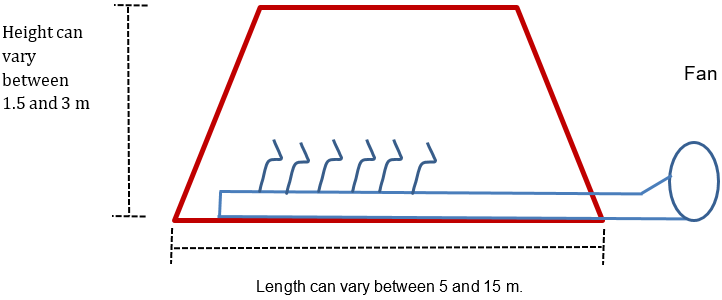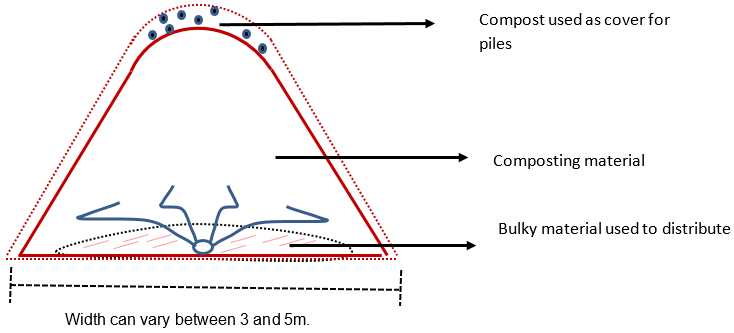Research Article
Volume 3 Issue 1 - 2021
Biosolids Composted by the Static Pile Maturation Method for its Application in Agriculture
1Faculty of Chemical Engineering, Meritorious Autonomous University of Puebla, University City
2Department of Research in Agricultural Sciences DICA-ICUAP, BUAP, Puebla
2Department of Research in Agricultural Sciences DICA-ICUAP, BUAP, Puebla
*Corresponding Author: Niño Lozano A, Faculty of Chemical Engineering, Meritorious Autonomous University of Puebla, University City
Received: February 19, 2021; Published: March 02, 2021
Abstract
The objective of this work was to know the quality of the compost obtained, of the bio solids generated in municipal wastewater treatment plants and a mixture of different organic materials that were obtained from public gardens and to analyze their effect on the yields in some crops. In this way, the quality of soils that have been degraded by agricultural activity and other anthropogenic actions near the capital of Puebla will be improved. Piles of: 2 m wide, 1 m high and 3.5 m long were built, placing 9 m3 of bio solids, it was mixed in a 2:1 ratio. With exposure to the wind and plastic cover or shading, the piles were periodically manipulated by shoveling or turning to aerate them, this phase is the aerobic part that lasted 3 months. The anaerobic phase consists of increasing the temperature and mixing with other organic residual materials, and they were covered for a period of 2 months, this stage is the static part and without movement until maturing or stable.
Keywords: Composting; Organic recycling material; Static maturation pile; Gardening waste and sewage lily.
Introduction
Bio solids are residues that result from wastewater treatment, these can be liquid, semi-solid or solid, they have a great nutritional value and a great field of application especially in agriculture, where they promote the growth of crops and plants, since they have a high content of macronutrients and micronutrients. The methods for treating biosolids as stabilizing media are the most effective in eliminating the development of biological reduction of volatile matter content, chemical oxidation of volatile matter, the addition of chemical agents to make the sludge unsuitable for microorganisms do not survive and that of applying heat in order to sterilize and disinfect the sludge [1-3]. Composting is the process in which a bio solid is subjected to a process where the organic material will undergo degradation in order to reduce the content of pathogenic microorganisms [4-9]. Composting biosolids is a very good alternative to control pathogenic organisms since bacteria of enteric origin are sensitive to temperatures that are higher than 42°C. This method of composting is carried out in two temperature ranges, the Mesophilic ranging from 10°C to 40°C and thermophilic ranging from 40°C to 71°C, the critical temperature to eliminate human pathogens is 55°C. It should be taken into account that the design and management of a composting plan will depend both on the measurement of the volume of materials available for composting, as well as the weight and volume of the finished product [10-13].
Materials and Methods
Table number 1 describes the 2: 1 ratio in the mixture of the m³ of crude biosolids over m³ of pruning residual material mixed in this proportion to obtain a proportional compost that is more efficient in its maturation.
| Residual Materials | Amount |
| 1st. Mix: (raw biosolids) / (pruning of botanical garden chip material) | 2.5 m³ 1 m³ |
| 2nd. Mix: (crude biosolids) / (pruning of green areas of botanical garden) | 2.5 m³ 1 m³ |
| 3rd. Mixture: (raw biosolids) / (pruning of crushed water lily material) | 2.5 m³ 1 m³ |
| 4th. Mix: (raw biosolids) / (corn bagasse material pruning) | 2.5 m³ 1 m³ |
| Total: (crude biosolids) / (pruning of organic waste materials) | 10 m³ 5 m³ |
Table 1. 2: 1 ratio of crude biosolids on pruning of residual materials used for the composting process.
The research within the laboratory was following the methodology presented in the manual of methodology of physicochemical analysis of compost of the Department of Research in Agricultural Sciences belonging to the Benemérita Universidad Autónoma de Puebla, as well as on a par with official Mexican standards in the matter bisolides and composting of biosolids. (NOM-004-SEMARNAT-2002) - (NADF-020-AMBT-2011). In the composting process, those responsible or agents of transformation are living beings, all those factors that may limit their life and development will also limit the process itself, the factors involved are: Temperature, in each phase of the process a series of microorganisms intervene, each of them with a different temperature range [14-16]. Humidity is essential for microorganisms, since water is the environment in which they live, move and feed, in the practice of composting, high humidity must always be avoided because it would displace oxygen and, consequently, the process would stop being anaerobic, on the other hand, if the amount of humidity in the static mixing and maturing pile or mound is low, the activity of the microorganisms decreases and consequently the process is delayed or slow [17-18]. In the aeration phase, oxygen is essential for microorganisms to be able to effectively decompose organic matter, therefore, the supply of air at all times must be ideal to maintain microbial activity, without the appearance of anaerobic conditions, which, in addition to hinder the process, lead to the appearance of odors and a product of inferior quality. In order for the anaerobic process not to start, a minimum of 10% aeration must be exceeded [19]. For this reason, it is important to mix and control the appropriate organic materials in the static pile or mound, since many of the organic residues, especially the grass, tend to become caked and generate a slow decomposition generating bad odors, in image 1 y 2, the method is illustrated static mixing and maturing pile
Results
The organic material that is obtained as a product of the controlled microbial action on organic waste and industrial waste of organic origin with these waste separately or well mixed, piles or mounds are formed, as indicated in figures 1and 2, that by action of microorganisms give rise to a material (organic matter), very useful for agricultural soils since it improves their structure and fertility.
Discussion
Feasibility studies in analysis of the quality of the compost for each support and amendment material, Studies of the characterization conditioning of the tests of the phytotoxicity of the finished product, Economic analysis of production costs and uses of composting with economic income, Agronomic and maturity characteristics of the compost obtained, Diagnosis of the phytotoxicity of the compost obtained, We can conclude that the composted biosolid can be applied in different types of crops due to the applied method and by mixing with other residuals, the maturation process called composted biosolid achieves as a final product a high content of % Moisture,% Organic Matter and excellent pH, allowing to have excellent characteristics of a natural organic fertilizer, enriched composting, improving the quality when used in any type of soil highly eroded by different anthropogenic activities and allows it to be used for various uses in the agriculture industry and avoiding the use of agrochemicals as fertilizers, thus avoiding soil contamination [20-23].
Conclusion
Once the biosolid was composted, analyzes were made to determine the macro and micro minerals (N, K, P, Cu, Zn, Fe, Ca, Mn) by means of atomic mass absorption, where the potassium was made by dilution, the standard method that is a mixture of acetylene gas with lamp for each element detected, analysis and characterization to see the amount of nutrients [24-26].
References
- Khan A, Fouzia I, 201, Asian Journal of Plant Science and Researche, Vol. 1, pp116.
- Chan YC, Sinha RK, (2011), Wang W, waste management research, USA, pp. 29.
- Trewavas A, A critical assessment of organic farming-and-food assertions with particular respect to the UK and the potential environmental benefits of no-till agriculture, Crop Protection, USA, (2004). pp.757.
- Granato, T. C. et al. (2004). Trace Element Concentrations in Soil, Corn Leaves and Grainafter Cessation of Biosolids Applications. Journal of Environmental Quality. Vol.33, pp. 2078-2089.
- O’Connor, G. A. et al. (2005), Sustainable Land Application: An Overview. Journal of EnvironmentalQuality. Vol. 34, pp. 7-17.
- Renner, R. (2000) Sewage Sludge, Pros & Cons Environmental Science & Technology. Vol., 34, pp. 1-19.
- Gavalda, D. (2005). Agronomic and Environmental Impacts of a Single Application of Heatdried Sludge on an Alfi sol. Science of Total Environment. Vol.343, pp. 97-109.
- Bañuelos, G. S. et al. (2007). Long-term Application of Biosolids on Apricot Production.Communications Soil Science Plant Analysis. Vol.38, pp. 1533-1549.
- Basta, N. T., Ryan, J. A. y R. L. Chaney, (2005). Trace Element Chemistry in Residualtreated Soil: Key Concepts and Metal Bioavailability. Journal of Enviromental Quality. Vol., 34, pp. 49-63.
- He, Z. L., Yang X. E. y P. J. Stofella. (2005). Trace Elements in Agroecosystems and Impactson the Environment. Journal of Trace Elements Medical Biology. Vol., 19, pp. 125-140.
- Hernández-Herrera J. M. et al. (2005). Application of sewage sludge, bovine manure and chemical fertilizer in the forage sorghum crop. International Journal of Environmental Pollution. Vol.1, number 21, pp. 31-36.
- González, F. E. et al. (2011). Bioavailability and fractionation of heavy metals in agricultural soils amended with biosolids of municipal origin. International Journal of Environmental Pollution. Vol.4, number 27, pp. 291-301.
- Granato, T. C. et al. (2004). Trace Element Concentrations in Soil, Corn Leaves and Grainafter Cessation of Biosolids Applications. Journal of Environmental Quality. Vol. 33, pp. 2078-2089.
- O’Connor, G. A. et al. (2005). Sustainable Land Application: An Overview. Journal of Environmental Quality. Vol., 34, pp. 7-17.
- Renner, R. (2000). Sewage Sludge, Pros & Cons Environmental Science & Technology. Vol., 34, pp. 1-19.
- Samaras, V., Tsadilas, C. D. y S. Stamatiadis, (2008). Eff ects of Repeated Appplication of Municipal Sewage Sludge on Soil Fertility, Cotton Yield and Nitrate Leaching Agronomy Journal. Vol., 100, pp. 477-483.
- Schiff man, S. S. y C. M. Williams, (2005). Science of Odor as a Potential Health Issue.Journal of Environmental Quality. Número, 34, pp. 129-138.
- Singh, R. P. y M. Agrawal, (2008). Potential Benefi ts and Risks of Land Application ofSewage Sludge. Waste Management. Vol. 28, pp. 347-358.
- Torri S. y R. Lavado, (2009). Plant Absorption of Trace Elements in Sludge Amended Soilsand Correlation with Soil Chemical Speciation. Journal of Hazards Materials. Vol. 166, pp. 1459-1465.
- SEMARNAT (2002). Official Mexican Standard NOM-004-SEMARNAT-2002. Environmental Protection. Sludge and biosolids. Specifications and maximum permissible limits of pollutants for their use and final disposal. Secretariat of the Environment and Natural Resources, Mexico.
- [NOM-NMX-AA-15 Method of cracking, Semarnat (2007), pp120.
- NOM-NMX-FF-109- SCFI- 2008 lombri composta, Semarnat, (2008), pp15.
- SEMARNAT (2011). Environmental Standard for the Federal District NADF-020-AMBT-2011, which establishes the minimum requirements for the production of compost from the organic fraction of urban, agricultural, livestock and forestry solid waste, as well as the minimum quality specifications of compost produced and / or distributed in the Federal District.
- Niño A, Rivera A, Ramirez A, (2012). European Journal of Experimental Biology, Vol. 2(1): 199-205.
- Niño A, Escobar A, Guevara S, European Journal of Experimental Biology, (2014).Vol.,4(5): pp16-23.
- Niño A, Escobar A, Zamora ME, Martínez U., (2015). Design and construction of a unit for the production of vermicompost from cattle-equine organic waste. European Journal of Experimental Biology. Vol.,5.,pp. 48-55.gy
Citation: Niño Lozano A, Velasco Hernández Ma A, Tamariz Flores V, Esparza Morales P. (2021). Biosolids Composted by the Static Pile Maturation Method for its Application in Agriculture. Journal of Biotechnology and Immunology 3(1).
Copyright: © 2021 Niño Lozano A. This is an open-access article distributed under the terms of the Creative Commons Attribution License, which permits unrestricted use, distribution, and reproduction in any medium, provided the original author and source are credited.




